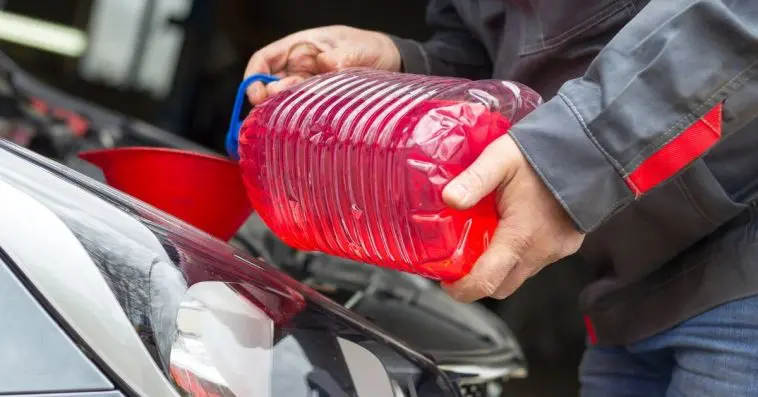The quick version: about $75-150 for normal service, another $15-30 if you want to change the transmission fluid filter, with the price rising to about $150-300 for a flush, and dropping to about $50-100.
With the quick price list out of the way, let’s get into the details of changing transmission fluid!
Now, first off, yes, this is yet another essential maintenance task, like changing your oil or replacing spark plugs.
The price ranges quite a bit, so you’ll probably want to ask your local mechanic of choice if you decide to have them do it, or just do it yourself after ordering the required materials to do it.
In this article, we’ll be going over what transmission fluid is, what it does, the cost of not changing it, the various elements inside it, what a pressurized flush is, and more!
TABLE OF CONTENTS
What Will It Cost To Change Transmission Fluid?
So, the specific cost is different for just about every car in different areas, with the answers I’ve given being the approximate cost.
There are a number of factors involved in the cost of changing transmission fluid: primarily, you have who does it, what type of transmission fluid change you are having done, and the car you have, as the price-affecting variables.
- First, the car you have, and how that affects the price. The make and model of your car determine 2 factors: how much and what type of transmission fluid you need. These two factors affect the material cost of the transmission fluid.
- The quantity of transmission fluid a car needs is generally between 5 and 15 quarts. Meanwhile, transmission fluid typically goes for $8-20 a quart. This means you could pay anywhere from $40-300 just for the transmission fluid alone, not counting labor or additional parts replaced, and this will also be your price if you change it yourself without doing anything else.
- Next, we have where you’re having it done. At a dealer or mechanic, the service charge brings the expected price up, and the service charge changes from place to place, and sometimes from car to car. Naturally, if you do it yourself, there isn’t any form of service charge, making it an appealing option if you have the time and tools, or can borrow the needed tools.
- After this, we have the type of change. You may just be replacing the fluid, you might have pressurized flush done, and you may need to change out the transmission filter or pan gasket, which are additional charges. So, how do these all breakdown?
- For just replacing the fluid, there are no additional charges or work that needs to be done. However, if you’re getting a transmission fluid flush done at a dealership or by a mechanic, you need to pay extra, as they use a special machine to totally clear out any gunk or old transmission fluid, you can expect to pay around $200-250 to have this done.
- Next, additional part replacement. When replacing your transmission fluid, generally you also want to replace your transmission fluid filter, and eventually, you’ll need to change the pan gasket. The filter should run you between 15 and 30 dollars, with the gasket going from 75 to 150 dollars.
Now, with the basics of pricing gone over, let’s get into the specifics of the transmission fluid itself.
Transmission Fluid: What Is It And How Often To Change It?
Transmission, in the long and short, is both a lubricant for the transmission and hydraulic fluid.
In addition to this, it helps in keeping the transmission within normal operating temperatures and aids in shifting gears, in addition to keeping your transmission from grinding to a halt and breaking.
Transmission fluid typically contains:
- Detergents
- Petroleum dye
- Cold flow improvers
- Anti-foaming additives
- Surfactants
- Anti-wear additives
- Lubricants
- Corrosion inhibitors
- Anti-oxidative compounds
- Viscosity modifiers
- Gasket conditioners
- Dispersants
Now, this transmission fluid needs to be replaced to keep your transmission working.
After all, your transmission runs anywhere from $1.5K to $3.5K, and the cost of changing transmission fluid is a lot less than the cost of changing the transmission.
Typically, a batch of transmission fluid will last for 30k to 60k miles, with the upper bound for certain transmission fluids designed for continuous use being around 150k miles.
Typically, sooner is better, however, and you should replace it at the first sign of needing to in order to keep your transmission working well and prevent damage from accumulating.
The signs you might need to replace transmission fluid are:
- Gears slipping
- Inability to shift
- Irregular shifting
- Delayed shifts
- Overheating transmission
On top of these signs and the rule of thumb, you have one more thing to check when replacing your transmission fluid.
Specifically, you should check the transmission fluid dipstick, and see what it looks and smells like, as strange as it may sound to smell it, it is important.
First, you should locate the transmission fluid dipstick on your car, it varies from car to car so you should look it up online or in the owner’s manual.
Next, you pull the dipstick out, and wipe it with a clean rag before replacing it and running your car for a few minutes, around five to ten.
After this, you should pull out the dipstick, and check how it looks and smells.
First, how it looks. There are two indicators that you need to take action: one, the fluid is very dark, and two, that the fluid levels are low.
There will typically be a mark showing you where “low” is, and if the fluid levels are there and the fluid is light/clear, you can just top it off. If the fluid is very dark, it is time to replace the fluid.
Second, how it smells. If it smells burnt at all, that’s a sign that your transmission fluid is, well, burnt, most likely from an overheating transmission.
If this is the case, like with having darkened fluid, you need to replace the transmission fluid.
In addition, I would also recommend driving more carefully, with fewer sudden shifts in what gear your car is in, as that’s the primary cause of overheating transmission fluid.
What Is A Pressurized Transmission Fluid Flush?
A transmission flush is a service provided by dealerships and mechanic shops with the necessary equipment, where they will use a flushing machine with a special transmission flushing fluid to, basically, power-wash your transmission and the systems related.
This is done because, over time, transmission fluid builds up contaminants, which manifest as sludge, grime, and floating bits of matter inside your transmission, which isn’t all removed when you simply change the transmission fluid.
It’s done about as often as a normal transmission fluid choice, with it being your choice as to flushing or simply replacing the fluid.
Something else to note, it is also possible to do this manually. I won’t get into the process here, but it is more of a mess and hassle than standard transmission fluid replacement.
Conclusion: A Trans Fluid Change Is Cheaper Than A Transmission Change
As we’ve already discussed, a trans fluid change is a few hundred dollars, tops, and only about 40 bucks on the low.
The cheapest trans you can expect to get is 1,500 dollars and is going to be a lot more work to install, not to mention it’ll probably fail on you while you’re driving.
For the safety of both you and your wallet, we recommend replacing your trans fluid when you need it, and hope this article proves helpful to you!




